The
United States Navy SEa, Air and Land Forces, commonly known as the
US Navy SEALs, are the
Special Operations Forces of the
U.S. Navy, employed in
direct action and
special reconnaissance operations. SEALs are also capable of employing
unconventional warfare,
foreign internal defense, and
counter-terrorism missions.
The US Navy Underwater Demolition Teams (UDT) were a precursor to the current United States Navy SEALs. Under-Water Demolition Teams began training in June 1943, one year before the invasion of Normandy. In World War II, UDT saw action at Normandy and at various locations in the South Pacific. The UDT refined and developed their commando tactics during the Korean War, with their efforts initially focused on demolitions and mine disposal.
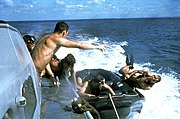
Underwater Demolition Team jumps over the side from boat.
President John F. Kennedy, aware of the situations in Southeast Asia, recognized the need for unconventional warfare and utilized Special Operations as a measure against guerrilla activity. In a speech to Congress in May 1961, Kennedy shared his deep respect for the Green Berets. He announced the government's plan to put a man on the moon, and, in the same speech, allocated over one hundred million dollars toward the strengthening of the Special Operations Forces in order to expand the strength of the American conventional forces.
Realizing the administration's favor of the US Army Special Forces, the Navy needed to determine its role within the Special Operations arena. In March 1961, the Chief of Naval Operations recommended the establishment of guerrilla and counter-guerrilla units. These units would be able to operate from sea, air or land. This was the beginning of the official Navy SEALs. Many SEAL members came from the Navy's UDT units, who had already gained experience in commando warfare in Korea, however, the UDTs were still necessary to the Navy's amphibious force.
The first two teams were on opposite coasts: Team Two in Little Creek, Virginia and Team One in Coronado, California. The men of the newly formed SEAL Teams were educated in such unconventional areas as hand-to-hand combat, high-altitude parachuting, safecracking, demolitions and languages. Among the varied tools and weapons required by the teams was the AR-15 assault rifle, a new design that evolved into today's M16. The SEALs attended UDT Replacement training and they spent some time cutting their teeth in UDTs. Upon making it to a SEAL Team, they would undergo a three-month SEAL Basic Indoctrination (SBI) training class at Camp Kerry in the Cuyamaca Mountains. After SBI training class, they would enter a platoon and train in platoon tactics (especially for the conflict in Vietnam).
The Pacific Command recognized Vietnam as a potential hot spot for conventional forces. At the beginning of 1962, the UDT started hydrographic surveys and Military Assistance Command Vietnam (MACV) was formed. In March 1962, SEALs were deployed to Vietnam for the purpose of training South Vietnamese commandos in the same methods they were trained themselves.
The Central Intelligence Agency began SEAL covert operations in early 1963. At the outset of the war, operations consisted of ambushing supply movements and locating and capturing North Vietnamese officers. Due to poor intelligence information, these operations were not very successful. When the SEALs were given the resources to develop their own intelligence, the information became much more timely and reliable.[citation needed] The SEALs and Special Operations in general started showing an immense success rate, earning their members a great number of citations.
The SEALs were initially deployed in and around Da Nang, training the South Vietnamese in combat diving, demolitions, and guerrilla/anti-guerrilla tactics. As the war continued, the SEALs found themselves positioned in the Rung Sat Special Zone where they were to disrupt the enemy supply and troop movements and in the Mekong Delta to fulfill riverine (fighting on the inland waterways) operations. The brown water of the Delta provided the foundation for the development of SEAL riverine operations. The braces, inlets, and estuaries intermingled and left a broad area for both the North and South to operate.
Combat with the Viet Cong was very close and personal. Unlike the conventional warfare methods of firing artillery into a coordinate location, or dropping bombs from thirty thousand feet, the SEALs operated within inches of their targets. SEALs had to kill at short range and respond without hesitation or be killed. Into the late 1960s, the SEALs made great headway with this new style of warfare. Theirs were the most effective anti-guerrilla and guerrilla actions in the war. The Viet Cong referred to them as "the men with green faces," due to the camouflage face-paint the SEALs wore during combat missions.
SEALs continued to make forays into North Vietnam and Laos, and unofficially into Cambodia, controlled by the Studies and Observations Group. The SEALs from Team Two started a unique deployment of SEAL team members working alone with South Vietnamese Commandos. In 1967, a SEAL unit named Detachment Bravo (Det Bravo) was formed to operate these mixed US/ARVN units, which were called South Vietnamese Provincial Reconnaissance Units (PRU).
At the beginning of 1968, the North Vietnamese and the Viet Cong orchestrated a major offensive against South Vietnam. Virtually every major city felt the effects of the "Tet Offensive." The North hoped it would prove to be America's Dien Bien Phu. They wanted to break the American public's desire to continue the war. As propaganda, the Tet Offensive was successful. America was weary of a war that could not be won, for principles no one was sure of. However, North Vietnam suffered tremendous casualties, and from a purely military standpoint, the Tet Offensive was a major disaster to the Communists.
By 1970, the US decided to remove itself from the conflict. President Richard Nixon initiated a Plan of Vietnamization, which would return the responsibility of defense back to the South Vietnamese. Conventional forces were being withdrawn. However, operations of the SEALs continued. The SEALS had developed a new base at the tip of the Ca Mau Peninsula and created a floating firebase, now known as Seafloat, by welding together fourteen barges. Accessible from sea, it also provided a landing area for helicopters.
On 6 June 1972, Lt. Melvin S. Dry was killed entering the water after jumping from a helicopter at least 35 feet above the surface. Part of an aborted SDV operation to retrieve prisoners of war, Lt. Dry was the last Navy SEAL killed in the Vietnam conflict. [1]
[edit] Training
[edit] Pipeline
Entering training to become a Navy SEAL is voluntary. Anyone can volunteer, and officers and enlisted men train side by side. In order to enter SEAL training, however, certain requirements have to be met. Those wishing to volunteer for SEAL training have to:
- be an active-duty, male member of the United States Navy.
- be 28 or younger (although waivers for 29 and 30 year olds are possible)
- have uncorrected vision no worse than 20/200 in both eyes correctable to 20/20 through contacts or glasses (corrective surgery PRK is also possible)
- be a US citizen
- obtain a GT score of 110 or higher on the ASVAB (Armed Services Vocational Aptitude Battery) test
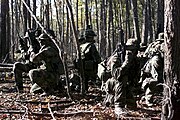
SEALs in woodlands operation
SEAL Training consists of the following:
- 3 weeks Indoctrination Course at Coronado, CA
- 24 weeks Basic Underwater Demolition/SEAL (BUD/S) training at the Naval Special Warfare Center in Coronado, California in San Diego
- 1 week of static line jump training, followed by 3 weeks of Military Free Fall (MFF) Qualification training at Tactical Air Operations in Otay, CA
- 3 weeks Basic Airborne School
- 15-week SEAL Qualification Training (SQT) at Coronado, California.
- 12-18 months SEAL Platoon Training
After completion of SQT, the SEAL trainee is officially awarded the coveted Trident (warfare device) and earns the title of "SEAL".[2]
[edit] Screening
Assignment to BUD/S is conditional on passing the PST, which requires the following minimal:
- 500-yard (457 m) swim using breast or side stroke in under 12:30
- At least 42 push-ups in 2 minutes
- At least 50 sit-ups in 2 minutes
- At least 6 pull-ups from a dead hang (no time limit)
- Run 1.5 miles (2.4 km) in boots and trousers 11:30
- Members’ vision must be no worse than 20/200 in both eyes. Vision must be correctable to 20/20. SEAL candidates may qualify for PRK surgery to correct their vision
Again, the above are the minimum requirements necessary to qualify for BUD/S. Prospective trainees are expected to far exceed these minimums. Competitive scores are as follows:
- 500-yard swim using breast or combat side stroke in 09:00 minutes or less
- 100 push-ups in 2 minutes
- 100 sit-ups in 2 minutes
- 20+ pull-ups from a dead hang (no time limit)
- Run 1.5 miles in boots and long pants in under 09:00
[edit] Basic Underwater Demolitions/SEAL (BUD/S)
Upon arrival at Naval Special Warfare Command, check-ins for BUD/S are immediately placed into a pre-indoctrination phase of training known as 'PTRR', or Physical Training Rehabilitation and Remediation. PTRR is also where all of the 'roll-backs' are placed while waiting to be put into a class. Once additional medical screening is given, and after enough BUD/S candidates arrive for the same class, organized physical training begins.
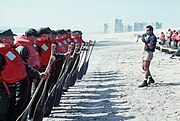
BUD/S Instructor talking to officers.
BUD/S consists of a three-week 'Indoctrination Course', known as INDOC, followed by three phases, covering physical conditioning (seven weeks), diving (eight weeks), and land warfare (nine weeks) respectively. Officer and enlisted personnel go through the same training program. It is designed to develop and test their stamina, leadership, and ability to work as a team.
In the first phase, BUD/S students are divided into 'Boat Crews' which can consist of six to eight men. Although some exercises will be undertaken as boat crews (such as 'log PT', which requires boats crews to exercise with logs that weigh 150 pounds (68 kg) each, and 'Surf Passage', where boat crews must navigate the Pacific surf in inflatable boats), the first phase of BUD/S also consists of a series of demanding individual physical tests including frequent sets of push-ups and sit-ups, ocean swims and timed four mile (6.4 km) runs in boots and long trousers, in soft sand (to be completed in 32 minutes). The first phase is most well known for 'Hell Week', 132 hours of continuous physical activity, which usually occurs during week four. A student may at any time drop on request (DOR) from the course. The tradition of DOR consists of dropping one's helmet liner next to a pole with a brass ship’s bell attached to it and ringing the bell three times (the bell was taken away for a few years in the 1990s, then later brought back.[3]

BUD/S trainees covered in mud.
Classes typically lose around 70–80% of their trainees--either due to DORs or injuries sustained during training, but it is not always easy to predict which of the trainees will DOR during BUD/S. Winter class dropout rates are usually higher due to the cold. SEAL instructors say that in every class, approximately 10 percent of the students simply do not have the physical ability to complete the training. Another 10–15 percent will definitely make it through unless they sustain a serious physical injury. The other 75–80 percent is 'up for grabs' depending on their motivation. There has been at least one BUD/S class where no one has completed the program. Most trainees are eliminated prior to completion of Hell Week, but trainees will continue to DOR in the second phase or be forced to leave because of injuries, or failing either the diving tests or the timed runs and swims. In fact, the instructors tell the students at the very start of BUD/S that the vast majority of them will not successfully complete the course and that they are free at any time to drop out (via the bell) if they do not believe they can complete the course. A trainee who DOR's from First Phase before the completion of Hell Week and reapplies to the BUD/S program must start from the beginning of INDOC (if they are accepted). Any BUD/S trainee who drops on request after Hell Week goes through the same out-processing as a trainee who quits before or during Hell Week. If they reapply to BUD/S they would stand a very good chance of being accepted, but they must complete Hell Week again.

BUD/S trainees in Diving Phase.
However, those who have completed Hell Week, but cannot continue training due to injury are usually rolled back into the next BUD/S class after Hell Week, or the respective phase in which they were rolled. There are many SEALs who have attempted BUD/S two or even perhaps three or more times before successfully completing training.
[edit] SEAL Qualification Training (SQT)
After BUD/S, graduates attend SEAL Qualification Training (SQT), which is the NEC 5326 awarding schoolhouse of NSW. SQT is an arduous 15 week program consisting of the basic and advanced skill sets required to be a SEAL. The BUD/S graduates attend a sequential course consisting of: TACAIR (static line and Freefall), SERE, Tactical Medicine, Communications, Cold Weather/Mountaineering, Maritime Operations, Combat Swimmer, Land Warfare (small unit tactics, light and heavy weapons, demolitions), and Close Quarters Combat.
The emphasis in SQT is building and developing individual operator skills with the concentration being on junior officer and non-commissioned officers. Students are assigned to 5 man Fire Teams with a officer or NCO leader. Each Fire Team leader is responsible for his subordinate students and many have been dropped from the program for failure to lead.
The course teaches current and standardized Naval Special Warfare tactics as they pertain to NSW mission sets. The goal of SQT is to send qualified new operators to the SEAL Teams. Attrition in SQT is still somewhat high, but is due to failure to grasp tactics or lead men, as opposed to being able to take the punishment of BUD/S Selection. Current attrition is roughly 3 drops and 5 rolls for every class. Most rolls are performance based with some medical rolls as well.
SQT is made up of commissioned and non-commissioned officers as well as former SOF civilian instructors. The civilian instructors come from all USSOCOM branches and help introduce the students to other US SOF units and doctrine.
Upon completion of SQT the students are awarded the Navy SEAL Trident, assigned to a SEAL Team, and are deployable. 20% of graduates deploy immediately to combat with their assigned team.
Enlisted members of the SEAL community are identified with the occupational rating of Special Warfare Operator (SO) and the (SEAL) warfare designator. For example, SO1(SEAL/FPJ) John Smith is identified as Special Warfare Operator 1st Class Petty Officer John Smith and is both SEAL and Free Fall Parachutist qualified.
[edit] SEAL Platoon Training
Once at a SEAL Team, operators are put into a platoon and begin a 18 month work up prior to deployment. The work up is divided into three phases. Phase one of a work-up is called the Professional Development Phase (PRODEV). PRODEV is a 6-month block where individual operators attend a number of schools and courses. These schools lead to required qualifications and designations that collectively allow the platoon to perform as an operational combat team. Depending on the team's and platoon's needs, operators can expect to acquire some of the following skills:
- Sniper
- Breaching
- Surreptitious Entry
- Electronic and Media Exploitation
- Technical Surveillance
- High Threat Protective Security (PSD)
- Advanced Weapons Training
- Advanced Driving Skills (Urban/Rural/Security)
- Advanced Climbing/Rope Skills
- Advanced Air Operations: HALO/HAHO/Jumpmaster/Parachute Rigger and Packer
- Diving Supervisor
- Range Safety Officer
- Instructor School
- Leadership School
- Foreign Weapons
- Unmanned Aerial Vehicle / Precision bombing Operator
- Language School
- Advanced Special Operations
Phase two of a work-up is called Unit Level Training (ULT). ULT is a 6-month block where the platoons train in their core mission areas (Land Warfare, Close Quarters Combat, Urban Warfare, Maritime Interdiction, Combat Swimmer, Long Range Interdiction, Air Operations, Special Reconnaissance and Maritime Operations, Advanced Marksmanship/Heavy Weapons).
Phase three of a work-up is called Squadron Integration Training (SIT). SIT is the last 6-month block where six platoons conduct advanced training with the supporting attachments of a SEAL Squadron, Special Boat Squadrons, Medical Teams, EOD, Interpreters, Intelligence/HUMINT Teams, Cryptological Support Teams, etc). A final Certification Exercise is conducted with the entire SEAL team to synchronize platoon operations under the Task Group umbrella. Following CERTEX, a SEAL Team becomes a SEAL Squadron and would deploy for six months.
[edit] Navy SEAL teams and structure
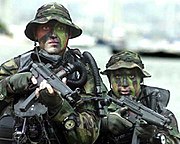
SEALs carrying
MP5 submachine guns
Naval Special Warfare Command is organized into the following configuration: Naval Special Warfare Group ONE/TWO: Contains the SEAL Teams 1-10; Naval Special Warfare Group THREE: Consisting of Undersea Mobility (SDV Teams); Naval Special Warfare Group FOUR: Consisting of Special Boat Squadrons/Teams; Naval Special Warfare Logsistics Support Group ONE/TWO: Consisting of all Combat Service Support; Naval Special Warfare Support Activity ONE / TWO: Consisting of all Intelligence collection (HUMINT/SIGINT), cryptological support as well as linguist, canine teams and environmental assessment teams.
SEAL teams are organized into two groups: Naval Special Warfare Group One (West Coast), and Naval Special Warfare Group Two (East Coast), which come under the command of Naval Special Warfare Command, stationed at NAB Coronado, California. As of 2006, there are eight confirmed Navy SEAL Teams. The original SEAL Teams in the Vietnam War were separated between West Coast (Team ONE) and East Coast (Team TWO) SEALs. The current SEAL Team deployments include Teams 1, 2, 3, 4, 5, 7, 8, and 10. The Teams deploy as Naval Special Warfare Squadron's or Special Operations Task Forces and can deploy anywhere in the world. Squadrons will normally be deployed and fall under a Joint Task Force (JTF) or a Combined Joint Special Operations Task Force (CJSOTF) as a Special Operations Task Force (SOTF)
A SEAL Team has a Staff Headquarters element and three 40-man Troops. Each Troop consist of a Headquarters element consisting of a Task Unit Commander (O-5), a Task Unit Senior Enlisted (E-8), a Targeting/Operations Officer (O-2/3) and a Targeting/Operations Leading/Chief Petty Officer (E-6/7). Under the HQ element are two SEAL platoons of 16 men (2 officers, 14 enlisted SEALs and sometimes 2 enlisted EOD Operators making a platoon of 18); a company-sized combat service support (CSS) consisting of staff N-codes (the Army and Marine Corps use S-codes); N1 Administrative support, N2 Intelligence, N3 Operations, N4 Logistics, N5 Plans and Targeting, and N8 Air/Medical. Each Troop can be easily task organized into 4 squads or eight 4-man fire teams for operational purposes. The size of each SEAL “Team” with Troops and support staff is approx. 300 personnel. The typical SEAL platoon of 16 men has an OIC (Officer in Charge, usually an O-3), an AOIC (Assistant Officer in Charge, usually an O-2), a platoon chief (E-7), an LPO (Leading Petty Officer, E-6) and others ranging from E-6 to E-4 (most are E-5). Occasionally there is a "third O". Usually the third O is an O-1 on his first operational deployment. This makes the platoon consist of 3 officers and 13 enlisted personnel. The core leadership in the Troop and Platoon are the Commander/OIC and the Senior Enlisted NCO (Senior Chief/Chief).
Troop core skills consist of: Sniper, Breacher, Communicator, Maritime/Engineering, Close Air Support, Corpsman, Point-man/Navigator, Primary Driver/Navigator (Rural/Urban/Protective Security), Heavy Weapons Operator, Sensitive Site Exploitation, Air Operations Master, Lead Climber, Lead Diver/Navigator, Interrogator, Explosive Ordnance Disposal, Technical Surveillance, and Advanced Special Operations.[citation needed]
Each SEAL Team is commanded by a Navy Commander (O-5), and has a number of operational SEAL platoons and a headquarters element. In 1987, SEAL Team 6 was renamed to the United States Naval Special Warfare Development Group, although members are still frequently referred to informally as "SEAL Team 6". Naval Amphibious Base Little Creek, a naval base in Virginia Beach, Virginia, is home to SEAL Teams 2, 4, 8, and 10. Naval Amphibious Base Coronado, a naval base in Coronado, CA, is home to SEAL Teams 1, 3, 5, and 7.[citation needed]There are also two SDV units, SDVT-1 located in Pearl Harbor, HI, and SDVT-2 in Virginia. SDV Teams are SEAL teams with an added underwater delivery capability.
A new resolution and merger has recently passed between the US Navy and the US Coast Guard allowing qualified Coast Guard personnel apply for selection and assignment to a SEAL Team. Qualified graduates will stay with the team for seven years before rotating back to the US Coast Guard. The agreement also helps strengthen the tactical leadership of the USCG as they take on a more direct role in coastal homeland defense.
[edit] Highlighted Navy SEALs
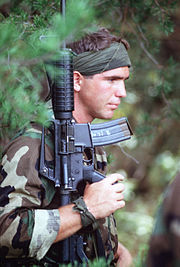
A SEAL during an exercise.
- Roy Boehm — first commanding officer of SEAL Team Two, considered godfather of all SEALs
- Rudy Boesch — competitor in the TV reality shows Survivor and Survivor: All-Stars
- Brian J Bovill — Vietnam War veteran, author, BUD/s Class 45 in 1969
- Michael Brown — SEAL Team SIX Intel Operator. Supported Team 6 as Intel Unit responsible for tracking Achille Lauro Cruisliner Hijackers in the Mediterranean in 1985. Received a Presidential Unit Citation from Ronald Reagan. 1985 6th Fleet Intel Advisor to Vice Admiral Frank Kelso (CDR Sixth Fleet) during conflicts with Libya - "Line of Death" incident. Stationed on the USS Yorktown (CG-48) during the sinking of two Libyan Patrol Boats.
- James F. Cahill - first person to scuba dive in New England waters, founder of first retail scuba diving chain, one of the first UDT members
- Christopher Cassidy - NASA Astronaut
- Dennis Chalker — plankowner of SEAL Team SIX and Red Cell
- Hershel Davis — Grandfather of SEALs during the 1980s and 1990s; Master Chief of Blackwater USA (PSC).
- Dick Couch — Author of several books on the Navy SEALs including The Warrior Elite: Forging of SEAL Class 228, The Finishing School, and Down Range: Navy SEALs in the War on Terrorism. Couch is a graduate of the US Naval Academy (Class of 1967) and BUD/S Class 45 (1969).
- John Gay — Bronze Star with Valor recipient. One of four Navy SEAL members from SEAL Team 6 to have participated in The First Battle of Mogadishu who was wounded in action with the Lost Convoy and notable for having a Randall knife deflect a stray bullet from inflicting serious injury[4]
- Bob Gormly — Commanding officer of SEAL Team 6 during the invasion of Grenada, author of Combat Swimmer
- Eric Greitens — Chairman of the Center for Citizen Leadership, Public Speaker, and Senior Fellow at the University of Missouri's Truman School of Public Affairs [5][6]
- Harry Humphries — Hollywood actor and technical advisor for films.
- Gary Jackson — president Blackwater USA, a private military contractor
- Bob Kerrey — Medal of Honor recipient; Democratic U.S. Senator from Nebraska (1989–2001); and president of The New School since 2001.
- Gerhard Klann — SEAL Team SIX Operator; claims he, along with Bob Kerrey committed war crimes in Thanh Phong, Vietnam.
- Marcus Luttrell — The sole survivor of Operation Red Wing, the deadliest single day in the history of SOCOM. Nineteen Special Operations Forces soldiers died during the operation; three from the original four man SEAL team and sixteen others when a QRF helicopter that had been sent to rescue the SEAL team was shot down by a RPG.
- Richard Machowicz — aka "Mack," former Navy SEAL and founder of Bukido training system and host of Discovery Channel's Futureweapons
- Richard Marcinko — founder of SEAL Team SIX and Red Cell; and co-author of New York Times bestseller Rogue Warrior
- Tom McGrath — commander of SEAL Team Four during the Operation Just Cause, which suffered four killed and eleven wounded at Patilla Airfield.
- Alden Mills — Inventor of The Perfect Pushup and The Perfect Pullup exercise products.
- Michael A. Monsoor — Awarded a posthumous Medal of Honor for jumping on an enemy hand grenade during a firefight in Iraq to save fellow SEALs.
- Fred "Tiz" Morrison — 1st African American Navy SEAL UDT Team 12 (Bronze Star Korean War).
- Michael P. Murphy — Medal of Honor recipient, exposed himself to fire while calling in support during Operation Red Wing in Afghanistan
- Thomas R. Norris — Vietnam War MACV-SOG Medal of Honor recipient and retired FBI agent.
- Eric T. Olson — The first SEAL to go on to become a three-star and four-star admiral. Also the first Navy SEAL to become the commander of U.S. Special Operations Command.
- Chuck Pfarrer — SEAL Team SIX operator; screenwriter with credits including The Jackal, Darkman, Red Planet, Virus, Hard Target, Navy SEALs; and author of the New York Times bestseller Warrior Soul and the reality-thriller Killing Ché
- Theodore Roosevelt IV — Vietnam-era SEAL great-grandson of President Theodore Roosevelt, BUD/s class 36
- William Shepherd — first American commander of the International Space Station
- Stew Smith — personal trainer, and author
- Doug Sofranko — Martial arts world champion
- Michael Thornton — Vietnam War and last non-posthumous Medal of Honor recipient.
- Jesse Ventura — served with UDT 12, became a professional wrestler, actor, and served as the 38th governor of Minnesota